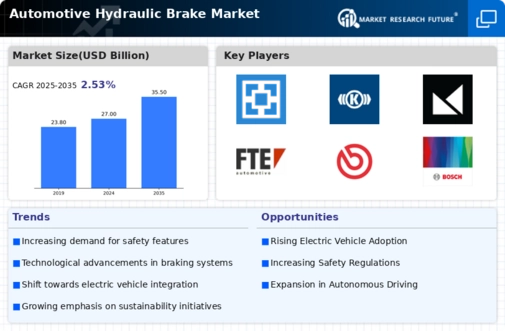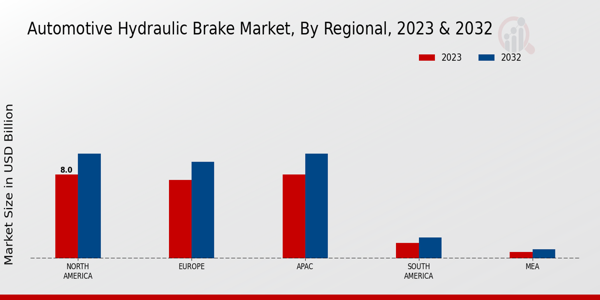Market Trends and Projections
Regulatory Compliance and Standards
Regulatory compliance plays a crucial role in shaping the Global Automotive Hydraulic Brake Market Industry. Governments worldwide are implementing stringent safety and environmental regulations that necessitate the use of advanced braking systems. Hydraulic brakes are often favored for their ability to meet these standards, particularly in terms of performance and reliability. As regulations evolve, manufacturers are compelled to upgrade their braking systems, thereby driving market growth. The emphasis on compliance not only enhances vehicle safety but also contributes to the overall market expansion, as companies invest in hydraulic brake technologies to adhere to these regulations.
Growing Demand for Vehicle Safety Features
The increasing emphasis on vehicle safety is a primary driver for the Global Automotive Hydraulic Brake Market Industry. Consumers and regulatory bodies alike are prioritizing advanced braking systems that enhance safety. Hydraulic brakes, known for their reliability and efficiency, are becoming standard in modern vehicles. This trend is reflected in the projected market value of 27.0 USD Billion in 2024, as manufacturers integrate these systems to meet safety regulations. The demand for features such as anti-lock braking systems (ABS) and electronic stability control (ESC) further propels the adoption of hydraulic brakes, indicating a robust growth trajectory in the industry.
Increasing Production of Electric Vehicles
The rise in electric vehicle (EV) production is reshaping the Global Automotive Hydraulic Brake Market Industry. As EVs gain traction, manufacturers are increasingly adopting hydraulic braking systems due to their effectiveness in managing the unique weight distribution and performance characteristics of electric vehicles. The market is anticipated to reach 35.5 USD Billion by 2035, driven by the growing consumer preference for EVs. Hydraulic brakes offer advantages such as reduced maintenance costs and improved braking performance, making them a preferred choice for EV manufacturers. This shift towards electrification is likely to sustain the demand for hydraulic braking systems in the coming years.
Technological Advancements in Brake Systems
Technological innovations are significantly influencing the Global Automotive Hydraulic Brake Market Industry. The integration of smart technologies, such as brake-by-wire systems and regenerative braking, is enhancing the performance and efficiency of hydraulic brakes. These advancements not only improve vehicle dynamics but also contribute to fuel efficiency and reduced emissions. As automakers invest in research and development, the market is expected to evolve, with a projected CAGR of 2.53% from 2025 to 2035. This growth is indicative of the industry's commitment to adopting cutting-edge technologies that align with global sustainability goals.
Rising Consumer Awareness about Brake Performance
Consumer awareness regarding the performance and reliability of braking systems is increasingly influencing the Global Automotive Hydraulic Brake Market Industry. As consumers become more informed about vehicle safety features, they are more likely to demand high-quality hydraulic brakes that ensure optimal performance. This trend is evident in the growing preference for vehicles equipped with advanced braking technologies. Manufacturers are responding by enhancing their hydraulic brake offerings, which is likely to contribute to the market's growth. The focus on performance and safety is expected to drive the adoption of hydraulic braking systems, aligning with consumer expectations and regulatory requirements.




















